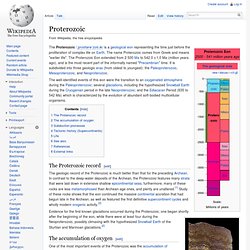

Mesoproterozoic Era: 1600 - 1000 mya. Neoproterozoic Era: 1000 - 542 mya. Proterozoic Eon. This was the period of early life on the Earth, which lasted from about 2.5 billion years ago to about 542 million years ago.

The record of this period is much better preserved than the Archean. Unlike Archean rocks, which have been greatly degraded due to their great age and metamorphosis (most strata was laid down in deep oceans); the Proterozoic strata has been much better preserved. Land had grown and become stable enough to allow large inland seas, and strata deposited in these areas is relatively well preserved. Several important things happened during the Proterozoic, including: the build up of large continents and orogeny (mountain building), with modern plate tectonics; the gradual change in the atmosphere with the build up of oxygen; the increasing complexity of life, from the earliest anaerobic life forms, to aerobic life, eukaryotes, multicellular life, and a profusion of complex life forms towards the end of the Proterozoic.
Very little is known about ancient landmasses. Proterozoic. The Proterozoic eon is a time in the Earth's history that occurred from 2.5 billion to 543 million years ago.

Many important events in the geologic history of the Earth occurred during this eon. For example, stable continental masses first appear and began to significantly grow in size through the accretion of sedimentary deposits. Also occurring during this time is the fossilization of our planet's earliest organisms, mainly bacteria and archaeans. By about 1.8 billion years ago, eukaryotic organisms begin to appear in the fossil record as well. Finally, multicellular eukaryotic life-forms become common near the end of the Proterozoic. During the middle of Proterozoic oxygen concentration in the atmosphere increases significantly.
The Proterozoic is divided up into three eras: Paleoproterozoic (2.5 to 1.6 billion years ago), Mesoproterozoic (1.6 billion to 900 million years ago) and Neoproterozoic (900 to 543 million years ago) (Figure 1). ^ Schopf, J. Citation Paleontology, U. (2012). Britannica Online Encyclopedia. From the Encyclopædia Britannica Proterozoic Eon, the younger of the two divisions of Precambrian time, the older being the Archean Eon.

The Proterozoic Eon extended from 2.5 billion to 541 million years ago and is often divided into the Paleoproterozoic (2.5 billion to 1.6 billion years ago), the Mesoproterozoic (1.6 billion to 1 billion years ago), and the Neoproterozoic (1 billion to 541 million years ago) eras. Proterozoic rocks have been identified on all the continents and often constitute important sources of metallic ores, notably of iron, gold, copper, uranium, and nickel. Oxygen is a by-product of photosynthesis. By the time eukaryotes became established in the environment, atmospheric oxygen pressure had risen from low values to about 10 percent of the present atmospheric level (PAL).
Early organisms on Earth flourished most easily in the shallow water of continental margins. The Proterozoic Eon. Online exhibits : Geologic time scale First, a few words about the Precambrian, an informal name for the vast expanse of time prior to the Phanerozoic Eon (which includes the Paleozoic, Mesozoic, and Cenozoic Eras).

The Earth formed. It then took nearly four thousand million years before the first animals would leave their traces on the planet. Proterozoic. The well-identified events of this eon were the transition to an oxygenated atmosphere during the Paleoproterozoic; several glaciations, including the hypothesized Snowball Earth during the Cryogenian period in the late Neoproterozoic; and the Ediacaran Period (635 to 542 Ma) which is characterized by the evolution of abundant soft-bodied multicellular organisms.

The Proterozoic record[edit] The geologic record of the Proterozoic is much better than that for the preceding Archean. In contrast to the deep-water deposits of the Archean, the Proterozoic features many strata that were laid down in extensive shallow epicontinental seas; furthermore, many of these rocks are less metamorphosed than Archean-age ones, and plenty are unaltered.[1] Study of these rocks shows that the eon continued the massive continental accretion that had begun late in the Archean, as well as featured the first definitive supercontinent cycles and wholly modern orogenic activity.[2]